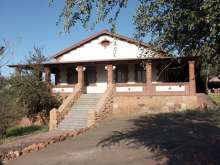History and culture
The first human inhabitants were the San people, who left rock engravings believed to be several thousand years old. A small tribe of the San were still living their traditional lifestyle on the plateau until the late 1960s.
The Dorsland trekkers, who stopped here around 1875-1880, named the plateau after the Waterberge in the Transvaal.
The Waterberg is historically important as the site of a major battle between the Herero people and the German colonial forces beween 1904 and 1907. The Herero were defeated and forced to retreat from the Waterberg into British Bechuanaland (now Botswana). This defeat was one of the major turning points in Namibia's history. Thousands of Hereros were killed by the pursuing Germans and many died in the harsh conditions of the Kalahari Desert. It is estimated that nearly two thirds of the Herero population died during this period. The graves of German soldiers who lost their lives at Waterberg can still be viewed near the Waterberg rest camp at the base of the park. The battle is commemorated every second weekend of August.
In the African Wild Dog conservancy there are holy monument places at Ozonguti and Okozonduzu.




